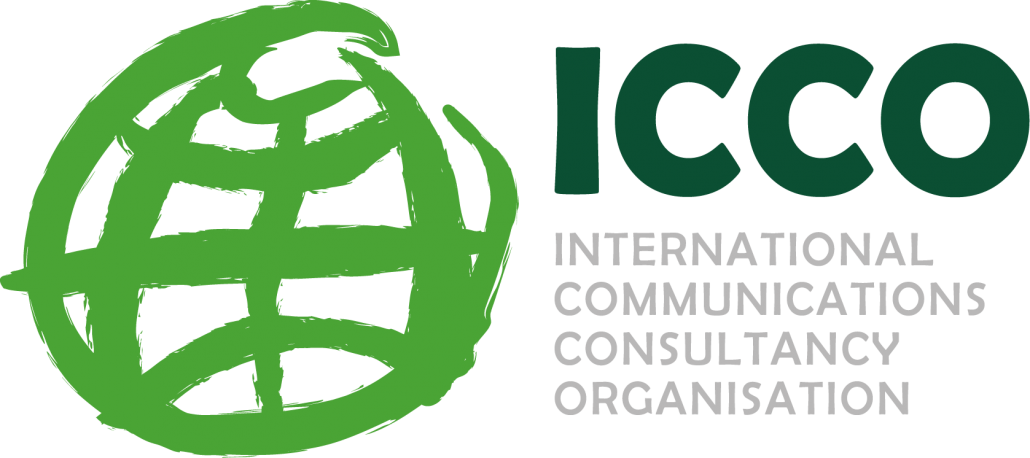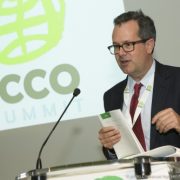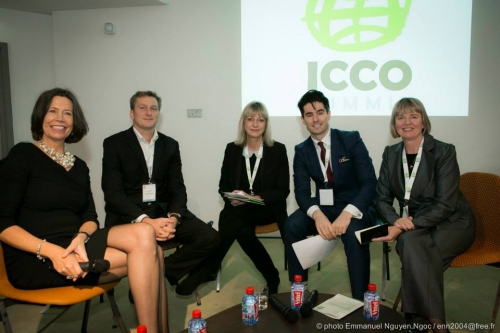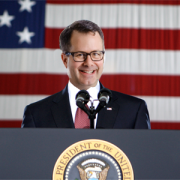Blog post by David Gallagher, Senior Partner and EMEA CEO of Ketchum, ICCO President
Twitter @TBone Gallagher
It is customary at various industry events to discuss issues of common concern – the rising power of procurement, the threat of other marketing disciplines and questions about where growth will come from and which industries to specialize in. It’s easy to define our common interests by our common challenges, and there is of course tremendous value in finding common ground through national associations and ICCO.
But I am by nature an optimist, and I’d prefer to focus on the reasons we have to celebrate our business and to discuss how we can continue to develop our industry in a way that benefits our people, our clients and our own personal aspirations.
In fact I’m so optimistic, so encouraged by what I’ve seen in my meetings around the world, that I can think of ten reasons to be happy in the PR consultancy business today.
1. PR is (almost) truly global.
For decades we’ve talked about the globalization of the PR business, and we have in fact seen consultancies arise and organize all over the world.
A key objective of ICCO is to help organize new associations wherever there’s interest. This further professionalizes the industry and expands the perspectives and insights we are able to share with our long-standing members. It also give us the scope and reach to begin organising into regional structures that will enable us to provide both a global perspective and regionally relevant agenda; in Europe, for example, we will host a Summit this autumn in France to focus on issues of European interest, and we’re looking at new ways to facilitate cooperation on specific items of interest to our members, like coordinated activity in Brussels.
We are in active conversations now with groups in Hong Kong and mainland China, as well as the very well-established and respected Council of PR Firms of Canada. We will host a summit in India next year, and we will fulfil a personal ambition of mine to begin working with groups and agencies in Africa, which promises to be the next big area of geographic growth for the industry.
2. PR is truly local.
While globalization steals the headlines, the real action may be in localization: through a combination of social media applications that focus on highly specific localization, and the tracking of search and post trends by city and even post-codes, the potential for PR is enormous.
Whether agencies work for local clients that now are now ‘turned on’ by PR and its potential, or for global multinationals, there are several trends worth noting:
- Content style is moving from the formal to informal, in all languages. This requires a detailed and nuanced understanding of how language and imagery are used locally, and creates opportunities for us to add value beyond mere translation to communications planning and activity.
- Beyond language and culture, there are opportunities to support clients locally in community management, customer support and other important aspects of client business.
- There will be opportunities to provide training and learning support to clients interested in working locally workforce’s knowledge and awareness of business practices and cultural norms.
- Global brands will continue to find ways to connect with local sensitivities and community-mindedness. McDonalds for example is experimenting with a MaccyD’s brand in Australia in recognition of how the brand is actually seen and discussed there.
Much of the ICCO agenda focuses on helping member associations track these trends and opportunities for the benefit of their member agencies. Training programmes, greatly upgraded with content and trainers from support through the UK PRCA will aim to give local agencies differentiation locally via their national associations, and our regional and global conferences will highlight learning and best practices from all over the world.
If you believe the trends of globalization and localization are real and will continue, the implications are clear. Global networks like Ketchum must find ways to reach into the local markets that are most important to our clients – which seems to be all of them – in ways that are efficient and consistent for the client, and interesting and rewarding for our people. And while local agencies don’t need to surrender their independence, they will want to find a way to connect with the wider world of expertise, information and opportunity. Here again, ICCO is committed to helping its member associations do just this.
3. Technology will set us free.
Without a doubt, the most important development in PR right now is the rise of Internet-driven communications. I could write a separate blog post discussing this, but I think it’s the most important opportunity for us in 60 years.
Agencies seem to respond in one of three ways:
- Ignore it
- Outsource it
- Transform their business around it
My personal belief is that this is a once in a generation opportunity to modernise the industry, and that the only viable strategy is to transform our business around the rise of digital applications and social media.
The writing is on the wall, and more than likely it is a Facebook wall. Organizations that fail to engage with their audiences in these new ways are on a path to self-destruction. Those that embrace this – and the agencies that show them how, are the ones that will succeed.
4. Psychology is the new black.
As exciting as a world linked and driven by technology is for our business, there’s a whole new universe of opportunity much closer to hand: our understanding of the human mind. While much of the action focuses on moving information and ideas from point to point around the world, there is increasing interest in how ideas and opinions and decisions form in the 3 pounds of the average human brain. Advances in brain imagery and neurology, and serious analysis of well-designed experiences in sociology and psychology, are offering dramatic insight into how we interpret and use information and emotions to make decisions about what we buy, how we vote, whether to smoke or who to marry.
We would rightly say that we’ve always put psychology and our understanding of human nature at the heart of our work, but I think we’ll see social science take on increasing prominence in our strategic work. Concepts like ‘nudging’ and ‘framing’ are increasingly common in the way agencies are planning and designing strategy, and candidates with credentials in psychology or anthropology are increasingly sought after.
At Ketchum we’ve enjoyed a partnership with another Omnicom company called Maslansky and Partners. Their basic assumption is that what we say as communicators is far less important than what audiences actually hear. And before you say this is obvious, think about how many times we have included key messages in our content without ever doing the research necessary to know if the messages work. Maslansky helps track the relative power of different messages with audiences with highly specific testing in advance of any production or communication.
5. Advertising value equivalency is dead.
Well, if it’s not dead, it’s dying. Those of you familiar with the Barcelona Principles created by the Association of Measurement and Evaluation in Communications will know that the industry is finally getting serious about ending the charade of measuring the value of our work by trying to compare it some kind of comparable form of advertising.
ICCO will be working closely with AMEC to educate our member associations and the client community on the benefits of better measurement and the use of analytics in public relations. We will be supporting their next global conference in June in Madrid and I would encourage you to attend or follow the proceedings closely. My good friend and Ketchum colleague David Rockland is president of AMEC and I assure you nobody in our world is more committed to the application of measurement and research in PR.
6. Advertising is our new frenemy.
A constant refrain at PR meetings is the competitive threat posed by advertising agencies and their incursions onto “our turf.” There is no doubt to me that the lines between the different channels of communications and marketing are blurring, and there will be times when assignments we thought should rightfully be “ours” will go to an ad agency – especially as clients struggle to understand the difference between our approach to social media and content and theirs.
But I think there’s a greater opportunity than risk posed by the advertising community, and that’s in working together to solve client problems. Rather than argue the superiority of PR or the supposed weaknesses of advertising, I think we would be better served looking for ways to foster collaboration and joined up thinking. Our clients will thank us, our work will be better, and ultimately we’ll create greater opportunities together than apart.
You can expect ICCO to remain committed to helping member associations voice the value of PR consultancy and good practice, but you can also expect us to open dialogue with those representing other communications disciplines, and to identify best practices for integrated communications among member agencies.
7. Internal communications – an emerging market right under our noses.
One of the fastest growing areas at Ketchum is internal communications and change management. Rather than trying to ‘convert’ our external communications specialists, we’ve hired organizational psychologists and other specialists to help clients with employee engagement and advocacy, recruiting and retention, and managing major change initiatives.
This line of work offers access to whole new client budgets, expands the areas in which we can add value and create new relationships, and obviously helps to align internal and external communications.
At ICCO we will investigate the interest among member associations for developing content, training and growth opportunities in this area.
8. Corporate communications is taking centre-stage
With greater transparency and openness comes greater scrutiny on corporate and institutional communicators. External audiences – consumers, customers, investors and regulators – want to know that companies are doing what they say they are doing. This presents an opportunity for communications advisors to frame corporate policy, not just the words to describe corporate policy.
It also ushers in a new age of expectations for leaders, who are now expected to be more than merely good decision-makers; they now must be great communicators – engaging and inspiring, and giving a sense of purpose to the organization’s business.
At Ketchum we collect data annually on what the public expects from leaders in terms of communications, and we plan on making this available through ICCO and our member associations.
9. Our creative moment in the sun is upon us.
This year I have the privilege and honour of serving as president of the PR jury at the Cannes Lions Festival of Creativity. Now I know there have been some questions in the past about the lack of winning entries coming from PR firms, and the value of supporting a competition that’s not a “pure “ PR event, and I’ll save these debates for another day.
I will say, however, that I’m encouraged by the number of PR agencies who say they are entering work for Cannes this year, and the quality of the work I have seen at other competitions like the SABRE awards, the PRCA awards, and PR Week awards, has every chance of shining on the stage this summer in France.
10. We are changing the world.
I say this with no sense of irony or cynicism. We have always helped our clients make a difference in the world by helping them understand the expectations placed upon them by their stakeholders and to align their words and actions with those expectations, and in many cases this work has been instrumental to improving the lives of millions.
And now it seems PR agencies are making more direct contributions to their communities and society in general by putting serious effort into their own corporate citizenship, not just that of their clients. Just about every agency I meet has a cause they support with pro bono services, and many are building CSR into their own culture and business practices, not just in their list of offers for clients.
At Ketchum we have been deeply connected to a global organization called Room To Read, which promotes literacy and advocates education for children – especially girls – in Asia and Africa, and we make significant agency resources available around the world. As you can imagine, agencies that ‘practice what they preach’ are attractive to clients, but also to employees, who increasingly have high expectations of their employers.
I am sure you have got your own examples of PR you have done to support causes you and your people care about, and I would invite you to share them with the world so that others might learn from and be inspired by your success. And I am offering this invitation literally – I am involved with a project developed in partnership with the World Economic Forum and the US Ad Council called Creative For Good, in which social education campaigns of all kinds are placed in a database for use and inspiration by others looking for creative help and guidance.
Selfishly I’m hoping to have lots of PR campaigns on the site as a way of not just saying we can solve big problems, but showing it. I hope you’ll feel free to contact me directly if you’re interested in this.




 The panel, made up of Ben Smith (
The panel, made up of Ben Smith (

 But logically, despite the carnage of the child bearing years which typically see a worrying chunk of talented women leave the industry, the preponderance of bright motivated women who either have no children or who are the primary bread winner should lead to at least equality in the boardroom. It will be interesting to see whether if in the next 10-15 years women reach the top of the industry to the degree that their number and talents deserve.
But logically, despite the carnage of the child bearing years which typically see a worrying chunk of talented women leave the industry, the preponderance of bright motivated women who either have no children or who are the primary bread winner should lead to at least equality in the boardroom. It will be interesting to see whether if in the next 10-15 years women reach the top of the industry to the degree that their number and talents deserve.